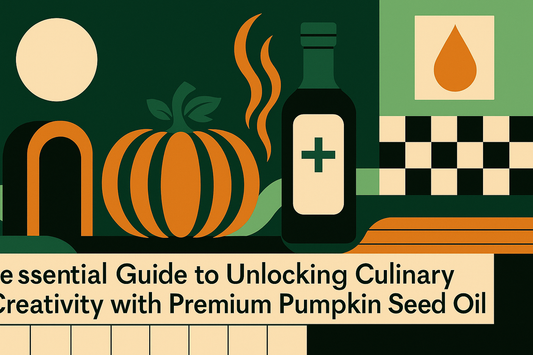
The Essential Guide to Selecting Premium Pumpkin Seed Oil
Introduction
The growing interest in pumpkin seed oil reflects a broader passion for natural wellness and healthy eating. As consumers become more discerning, understanding how to choose pumpkin seed oil is essential when navigating a market with many options. This guide explores what makes a premium pumpkin seed oil truly special, offering clear pointers on buying high-quality pumpkin seed oil and making well-informed choices that elevate your daily routine.
Understanding Pumpkin Seed Oil
What is Pumpkin Seed Oil?
Pumpkin seed oil is produced by extracting oil from the seeds of pumpkins. It boasts a rich history deeply embedded in culinary traditions and has long been valued for its distinctive flavor and nutritional components. Today, advancements in processing have refined the extraction methods to preserve its natural benefits. This guide explains how to choose pumpkin seed oil that meets modern quality standards while embracing time-honored practices.
Nutritional Highlights
The oil is celebrated for its array of beneficial compounds, including antioxidants, healthy fatty acids, and phytosterols. These components have contributed to its reputation as a nutritious addition to many diets. It is important to note that nutritional statements in this article are solely informational and should not be taken as a guarantee of performance.
Key Factors in Choosing Quality Pumpkin Seed Oil
Source and Origin
One of the most vital aspects in selecting a premium pumpkin seed oil is knowing its origin. The geographic source often reflects the quality of the raw materials and the care taken during production. A product produced in a region with a rich history tied to pumpkin cultivation is likely to have met stringent production standards. For instance, some producers place great emphasis on their heritage and the specific conditions of their growing environment.
Production and Extraction Methods
The method of extraction plays a crucial role in retaining the oil's natural properties. Modern techniques are designed to optimize the balance between flavor and the preservation of nutrients, ensuring that the final product maintains a superior nutritional profile. Unlike traditional methods, these contemporary processes are carefully calibrated to support a consistent quality throughout the production run.
Quality Certifications and Packaging
When examining labels, key information such as certifications and packaging details can indicate overall freshness and authenticity. A reliable pumpkin seed oil product will often display markers regarding its production date, storage conditions, and approved quality standards. By reading these labels carefully, shoppers can confidently determine that they are investing in a quality pumpkin seed oil product.
Practical Tips for Usage and Storage
Culinary Incorporation
Integrating premium pumpkin seed oil into your cooking is simple and rewarding. Its unique flavor enhances a variety of dishes, from crisp salads and homemade dressings to smoothies where a hint of nutty richness is desired. Experimenting with small quantities in your favorite recipes is a thoughtful way to enjoy the oil without compromising its nutritional benefits.
Storage Best Practices
To retain the oil’s quality, it is best stored in an airtight container placed in a cool, dark location. This practice helps protect it from light and heat, which can otherwise lead to oxidation. Following these straightforward storage tips ensures that your pumpkin seed oil remains fresh and effective for extended periods.
Conclusion
In summary, selecting a quality pumpkin seed oil involves considering its source, production techniques, and packaging details. This essential guide offers a reliable checklist for making an informed purchase, whether you are focused on boosting daily nutritional intake or simply enjoying new flavor dimensions in your meals. As you continue to explore options for premium pumpkin seed oil, remember that careful examination and simple best practices go a long way in ensuring that every choice you make leads to greater culinary enjoyment.
FAQs
What are the most important indicators of a quality pumpkin seed oil on the label?
Look for clear information regarding the source of the oil, any certifications, and packaging details that highlight freshness and authenticity. These indicators can serve as effective guides when determining the product's overall quality.
How does the extraction method affect the oil’s quality?
Modern extraction methods are designed to preserve key nutritional components, offering a superior sensory experience. The process is detailed on many product labels or in product descriptions, providing insight into the oil’s quality and consistency.
What are the recommended storage practices for pumpkin seed oil?
Storing pumpkin seed oil in a cool, dark place with an airtight container is advisable. This practice helps maintain its quality over time by protecting it from light and heat exposure.
By using this guide as a checklist when buying high-quality pumpkin seed oil, you can feel more confident in your choices. Consider exploring options that truly stand out for their production methods and authentic origins, ensuring a delightful addition to your culinary creations.



